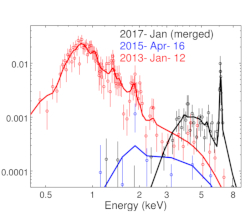 HEAPOW: The Breakup? (2018 Jul 23)
HEAPOW: The Breakup? (2018 Jul 23)
The young star named RW Aurigae A is known for its peculiar behavior: every few years, light from the star fades for a duration of a few months, then the light recovers to its former brightness. The origin of these dimming events are not fully understood. RW Aur A is surrounded by a thick disk of proto-planetary material in which planets are probably forming, and it may be that the faint episodes occur when a particulary thick portion of the disk comes between the star and the observer. Recently, X-ray and optical observations seem to show that the star's bizarre behavior has increased. The image above shows a record of the X-ray emission from the star, as measured by the Chandra X-ray Observatory on three separate occasions, in 2013 (in red), 2015 (in blue) and in 2017 (in black). The data plots show the relative brightness of the star versus X-ray energy; low energies are shown towards the left, and higher energy X-rays towards the right. These data tell an interesting and unusual story. In 2013, the X-ray emission was bright, and skewed towards low energy X-rays. In 2015, however, the source became very faint, and most of the emission detected was at higher X-ray energies. Then, in 2017, the star suddenly brightened, but only at high energies; no lower energy photons were detected. This suggests the appearance of a large amount of material which preferentially absorbs low energy X-rays. In addition, the narrow emission spike at energies between 6 & 7 keV signals the presence of a large quantity of the element iron. Astronomers are still not sure what caused the large change in the X-ray emission. One exciting possibility is the break-up of an iron-rich planet in the disk surrounding RW Aur A, possibly due to the collision with another small planet. If so, the iron-rich material was probably swallowed by RW Aur A, which may be the first documented case of a star swallowing one of its planets.
Chandra May Have First Evidence of a Young Star Devouring a Planet
viewtopic.php?t=38528
| << Previous HEAPOW | High Energy Astrophysics Picture of the Week | Next HEAPOW >> |